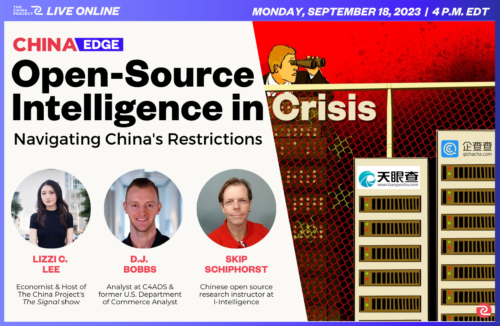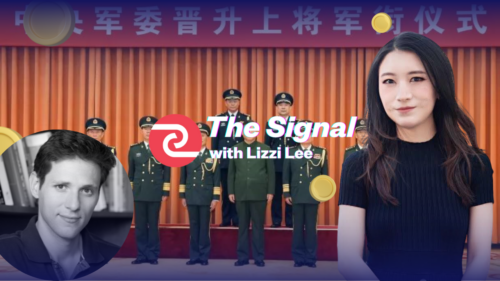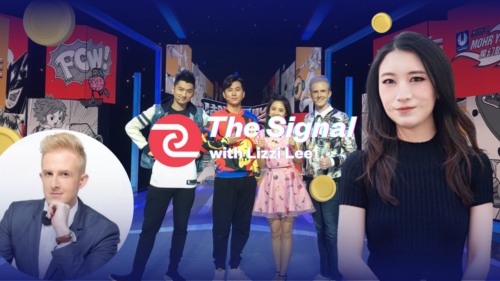Is China winning the AI battle with the U.S.? | The Signal with Lizzi Lee
AJ Cortese is a research associate at the Paulson Institute, where he conducts research and produces informative analysis covering China’s digital economy, technology sectors, and related policy dynamics within a U.S.-China context.

Below is a transcript of the video:
Lizzi Lee: Hello and welcome to this episode of Life with Lizzi Lee. I am your host Lizzi. Today we have AJ Cortese with us. He is a research associate at the Paulson Institute. Thank you so much for joining me, AJ.
AJ Cortese: Thanks for having me. Great to be with you.
Lizzi: You recently published a research report analyzing the collaboration competition between U.S. and Chinese AI talent. Can you sort of walk us through the research procedure? How did you begin your investigation and what are the main takeaways?
AJ: Sure. Thanks, Lizzi. At MarcoPolo, which is the Paulson Institute’s affiliated think tank. We’ve actually been looking at talents between the U.S. and China, going back a few years with the release of our global Talent Tracker, which is one of our digital projects, which looked at the flow of top-tier A.I. researchers between the U.S., China and other countries, where they get their degrees and where they end up staying and working.
And this is something we had some foundation in. And I think when the arrival of generative A.I. products like chatGPT really went viral at the end of last year and early this year with GPT4. we knew that there was a lot of excitement on both sides of the Pacific from U.S. tech companies and Chinese tech companies alike, all trying to get in and release really impressive products. And so, at that point, we knew that talent was the most determining factor of whether these efforts would be successful. And so we decided to take a deeper look at the talent landscape in AI. And specifically, in this report, we looked at the talent at Openai, AI, and GPT.
Lizzi: In the report, you also highlight the role of Microsoft Research Asia, a talent incubator for both U.S. and China. I wonder if you can elaborate on that example a little bit more. What are the factors contributing to this or success in fostering talent?
AJ: Sure. So the example of Microsoft Research Asia is really an interesting one because first of all, it started back in 1998, 1999, and so it was a very different geopolitical landscape at that time. You know, American companies wanted access to the Chinese market and they were expanding there not only in their operations but also in research centers. So Microsoft Research Asia was Microsoft’s first overseas R&D center. And today, I believe it is also its most significant. And so what this allowed Microsoft to do was to leverage some of its leading research and resources in A.I. and really tap into a reserve of Chinese talents. And so some of the best Chinese technical engineers and computer scientists in the nineties and early 2000s would end up at Microsoft Research Asia, where they would really hone their skills and progress and contribute to not only research in the field, but many of them would go on to make contributions in the private sector, either at top Western tech firms or increasingly leading technical teams at tech companies in China as well.
Lizzi: Fantastic. So your research also talks about synergies between U.S. and Chinese talent. I wonder if you can share with us some specific examples of collaborations between the United States and China that have led to significant investment in technology.
AJ: Sure. And so, just to add to touch on this flow of talent between Microsoft Research Asia and the U.S. and China, there were significant executives in the Chinese tech space that was a result of Microsoft Research Asia. I’m referring to, for example, one of Baidu’s chief scientists, as well as a scientist who went on to Bytedance’s lab after 15 years at Microsoft Research Asia. We also have a chief technology officer, who was a decade-long veteran at Microsoft Research Asia, as well as some of the top scientists at Megvii, the Chinese Computer Vision company. So I think it’s important to note that these talent links exist both in the private sector and in the research realm when it comes to research between the US and China. Microsoft Research Asia has made some significant contributions to the field overall.
The most consequential of which probably came in 2015 when a team from Microsoft Research Asia blew away the competition at the global image recognition competition called ImageNet. And that performance came from a crucial breakthrough in deep learning network architecture. And this paper was hugely consequential in the deep learning and AI field. And the authors of that paper went on to bigger careers in AI, one of which went on to found Megvii. So these talent pipelines between the U.S. and China really helped to augment the overall research environment around AI and really helped commercialize a lot of critical technologies in the field.
Lizzi: And so your research also indicates a super interesting phenomenon, which is this talent flow between the United States and China. Many Chinese scientists are educated in the United States, and they stay on in the U.S. to continue their careers and research.
But there seems to be this decline in Chinese students pursuing computer science and math degrees in the United States in the past few years. Can you elaborate on that a little more? How do you envision the future of talent migration between the United States? As you know, both government seems to be trying their best to attract global talents.
AJ: Sure. So the general decline in the number of Chinese students in computer science and mathematics courses in the U.S. is actually more from the impact of pandemic-related travel restrictions over the last couple of years. If you look at some of the underlying data, it’s actually more encouraging because a greater proportion of Chinese students that come to the U.S. are actually enrolling in computer science and mathematics courses.
So while there is an overall decline in the volume over the last couple of years, the proportion of Chinese students interested in these relevant disciplines is actually increasing. So that means that as the overall trend recovers from the post-pandemic impact, we’re hoping to see that the U.S. will continue to attract a growing number of Chinese computer science and math talents.
And this is important because, as something in our global data tracker shows, one of the key elements of a successful A.I. career is a graduate degree from a U.S. university. So that’s something that a lot of our data has shown. And also over, close to 90% of Chinese computer science graduate students who complete a degree in the U.S. end up staying and working in the U.S. So that’s obviously a significant competitive advantage in the talent competition for the United States. That said, we are also becoming more reliant on foreign STEM talent. So, for example, if the United States did not have any foreign STEM talent, it would only have about 20,000 PhDs as of 2019, which is less than half the number in China. But thanks to the inflow of highly skilled foreign talent, we see that the U.S. is actually able to graduate closer to 33,000 STEM Ph.D. So that’s a large percentage coming from foreign-born workers.
And that actually bears out in some other integration data that we’ve seen where STEM workers in the United States, foreign-born STEM workers are more likely to hold a graduate degree than their U.S.-born counterparts. So it’s not just that these talents are really coming in and making a difference, but they’re really making a difference at the top end of the spectrum in the premium talent category, which is obviously crucial to AI development itself.
Lizzi: I also wanted to turn to regulations a little bit. How would you describe the differences in regulatory landscapes between the United States and China? How do those variations influence the direction and focus of the research and development in China and U.S. respectively?
AJ: Sure. So there are different regulatory landscapes, but it’s also important to understand that the regulation isn’t always up to date with the technology. So I think we’re still in the midst of an evolving landscape where governments are trying to really get a handle on the implications for these technologies. That being said, I think that Chinese regulators are much more aware to the potential risks of this technology. We’ve seen in the generative AI frenzy recently that Chinese regulators were calling for caution in how they wanted to release these products. And I think this really is an interesting dynamic in that Openai just sort of released strategy and is now iterating and gathering all this user data feedback to further train its programs, whereas Chinese equivalents, like maybe if it’s Baidu or Sensetime or other companies, they’ve had to really be a little more careful in their rollout of these products.
Given the potential for generative AI chatbots to output to be potentially politically sensitive, I think that could be understood to be an unsurprising reality. Still, I think that these regulatory standards are going to have to try and evolve to keep pace with the technology. But for now, it seems China is taking a more cautious approach with more guardrails when it comes to generative AI technology. Going forward, in broader scope, I think we might see that Chinese or a little more Chinese companies and regulators and researchers might be a little more inclined to embrace enterprise-facing solutions which are perhaps less high profile and have less public-facing consumer implications to the broader society.
So that means integrating AI into industrial applications to increase efficiency, whereas some Western tech might be more focused on consumer applications. So again, these are just preliminary observations and the regulatory landscape will continue to shift. I think the United States is certainly going to need to get a handle on that. We’ve seen some constituents calling for a pause on research. And so I think this will be a continuing question down the road for sure.
Lizzi: And finally, let’s talk about money investment in terms of funding. How do public and private and private investment strategies differ in the United States and in China? What are some of the long-term implications of those differences on development?
AJ: Sure. So funding is very important, but I don’t think we’re necessarily seeing the bifurcation of a US camp in a Chinese camp that many might think. In fact, we’re seeing that investors are genuinely global and multinational and are looking for quality projects wherever they may be. We’ve seen that because there are significant U.S. investments in Chinese startups and vice versa.
So it’s important to understand that the investment links in this area are fairly intertwined regarding public versus private. I would go back to what I mentioned in terms of state capital might be a little more inclined to go with enterprise-facing solutions. In contrast, private capital might embrace consumer applications a bit more. But at the same time, I think we’re seeing that, you know, Chinese regulators have had AI on their radar for some time now.
I think these recent advances are only going to increase their priority and encourage them to devote more resources to not only understanding technology and legislating accordingly but also to how to implement it most effectively, given China’s economic strengths in areas like, say, advanced manufacturing. So I think that’s really something to look out for, and that’s something that global investors are aware of and how they can augment each country’s strengths.






